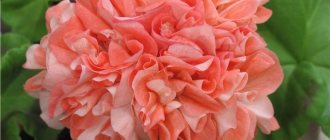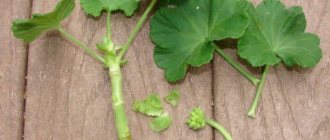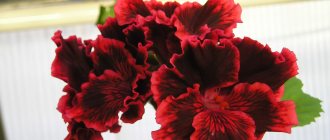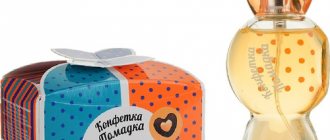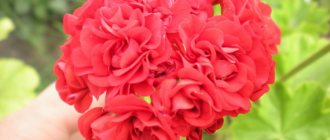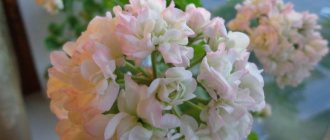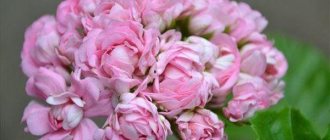Pelargoniums have won the love of many gardeners. Luxurious decorative flowers with a delicate aroma transform any room. Thanks to the efforts of breeders, the range of crop varieties is constantly expanding. The variety of shades and shapes makes it possible for everyone to find a plant to their liking. One of the popular groups is the South Pelargonium. Let's consider the characteristics and features of growing these flowers.
general description
Pelargoniums are part of the Geranium family. It unites several hundred plant species. These are both subshrubs and herbaceous specimens. Only a few types of pelargonium are grown at home. But even so, the choice is very wide.
Flowers have a variety of colors. They form small or large inflorescences in the form of umbrellas. White, soft and bright pink, red, burgundy, purple and other expressive tones leave no one indifferent. The colors can be either monochromatic or combined. The leaves are simple but beautiful. They are usually green, but there are other options, including variegated ones. Plants are perennial.
Pelargoniums of the YUG series are the creations of the wonderful breeder Yulia Gonchar from the Voronezh region. Actually, the large letters in the names of the varieties actually mean the initials of the creator. All varieties bred by Julia bloom readily and profusely. The bushes are usually compact and fluffy. The exception is YUG-Shukar, which is of average height and requires shaping.
Appearance and varieties
Pelargonium is a perennial herbaceous or subshrub plant. The inflorescences have an irregular shape. Petals are white, pink, and shades of red.
The fruit is a seed capsule with sepals. The foliage is green, covered with small fibers. The leaves have a pleasant smell.
Experts in the field of botany count over 250 varieties of pelargonium, which are divided into 30 groups. Main groups :
- zonal;
- ivy-leaved;
- fragrant;
- royal;
- angels;
- unique.
Greenhouse farms in Great Britain, Belgium, Holland, and Russia are engaged in the selection of pelargonium. I would like to highlight the domestic amateur breeder Yulia Gonchar. She has the following varieties :
- Pelargonium South-Aksinya.
- South Alexandra.
- South Anisa.
- South-Giselle.
- South Yesenia.
- South Deya.
- South-Tamil.
- South Ireland.
- South Siberia.
- Yug-Eter and others.
Varieties
The group includes an impressive number of varieties. Let's look at the most popular of them in more detail.
- SOUTH-Shukar. This is a zonal variety. The dimensions of the plant are standard. To give the bush a decorative shape, it should be trimmed regularly. Inflorescences are located on all sides. Flowers can be regular or double. The rich cherry-scarlet color of the petals makes the plant very impressive. The foliage is dark green.
- SOUTH-Jadwiga . Bright pink large flowers form lush caps of inflorescences. The bush is strong and compact. It does not require formation, it grows cute and very neat. The leaves are green, ordinary.
- SOUTH-Sakura . This variety received this name because the voluminous double flowers of delicate colors really resemble the culture of the same name. The petals are colored light pink. Crimson rays radiate from the center of the flower, giving it even greater expressiveness. The foliage is medium green, dense, without zonation. The edges of the leaves are framed by small teeth.
- SOUTH-Varvara is beautiful. This is an adorable dwarf. The bush is dense and has a beautiful regular shape. No pruning required. Blooming double buds resemble roses or mini-peonies. The light pink monochromatic color of the petals becomes brighter in the light. Abundant and long flowering pleases the gardener with lush inflorescences reminiscent of bridal bouquets.
- SOUTH-Zlatoslava. A very bright dwarf variety. The dense green foliage with a golden tint is beautiful in itself. Wavy purple-pink flowers complete the look, making the plant a worthy addition to any room.
- SOUTH-Claudia. White and pink fluffy flower caps decorate a compact bush with rich green leaves. The plant does not require formation. The variety is very popular among romantic representatives of the fair sex who are interested in floriculture.
- SOUTH-Princess Grace. It is no coincidence that the royal name was given to this variety. This luxurious pelargonium will become a real star in the collection of any gardener. The plant resembles a rose bush. Rough green leaves and large buds, shaped like a rose when opened, attract the eye. The shade of the petals is soft pink with tints.
- SOUTH-Nina. Another embodiment of tenderness. This magnificent rosebud has golden foliage. Each leaf has an ornate brown border. Densely double flowers have a pale pink color with a soft purple tint. Flowering is abundant. The bush is neat and forms itself. Stems and peduncles point upward. Growth type: dwarf. The variety received its name in honor of Yulia’s grandmother.
Landing
It is better to choose a small clay container for planting. The dimensions of the pot have a direct connection with the formation of the bush and the abundance of flowering. In large containers the culture hardly blooms.
A drainage layer (about 2 cm) should be placed at the bottom The plant should be moved very carefully so as not to damage the delicate root system. You need to carefully cover the roots with soil without compacting them. Finally, you need to water the flower with clean warm water. Only settled or filtered liquid is suitable for irrigation
Conditions of detention
The culture is photophilous. The best places for placement are southern and eastern window sills. For the bush to fully develop and form a neat shape, it should be periodically rotated relative to the window: this way, all its sides will receive an equal amount of light. If there is not enough lighting, the gardener will know this by the yellowness of the foliage.
In this case, you need to regularly ventilate the room. Fresh air will allow the crop to maintain a vigorous appearance, bright leaves and lush flowers. Air humidity is not a very important factor for SOUTH pelargonium. However, if you want to provide the most comfortable conditions for your green pet, keep this indicator at 60%. There is no need to spray the plants.
In spring and summer, the optimal temperature will be from 20 to 23°. The plant does not tolerate heat very well. In winter the flower rests. During this period, it is better to provide it with a temperature regime of 15 to 17°.
The soil
For the pelargoniums of this group, loose, nutritious soil is suitable. In addition, it must be water- and breathable. A gardener can take the easy route and purchase soil mixture at the store. You can prepare the soil yourself. In this case, you should take in equal shares:
The acidity level should be neutral. The culture does not like transplantation. Therefore, the plant should be moved maximum once every 2–3 years.
Conditions for growing indoor flowers
Pelargonium is an undemanding indoor flower . However, for a healthy and beautiful appearance, comfortable conditions are important for the plant.
- An indoor flower should be watered abundantly, but at the same time the water should not stagnate in the pot. Watering is needed abundantly, daily, especially in hot weather. In winter, you don’t need to water much, but you should not let the soil dry out completely. If watering is abundant, traces of gray rot appear on the leaves, and sometimes the stem rots, which can lead to the loss of the plant. If you water little, the flower withers, the leaves begin to turn yellow and dry out.
- Air humidity is not particularly important for pelargonium; on the contrary, excess moisture and stagnant air can cause fungal diseases of the flower. Spraying should not be done.
- In the warm season, the optimal temperature is +18 -22 C°. Sufficiently high air temperatures, especially indoors, will also negatively affect the plant.
- In winter, pelargonium is in a state of sleep. Plants should be moved to a room with a temperature of +12°C and regular ventilation. This could be a loggia, balcony, greenhouse. Watering should be sparse. Wintering lasts approximately from November to February. At the end of winter, pelargonium begins to gradually wake up.
- Replanting and pruning. These procedures should be performed annually, preferably in the spring, in mid-March. In order for the plant to have a lush appearance, it is necessary to trim the pieces. Perform this procedure only with a sharp knife diagonally. Broken parts of the plant may be affected by rot. And to enhance growth and branching, shoots are pinched.
- To ensure adequate nutrition, the flower needs to be fed and organic fertilizers applied. But it is important to dose the fertilizer and follow all the instructions indicated on the packaging:
- Feed “Mr. Color” Saintpaulia during or before flowering with 1 capful per 1 liter of water.
- "Gilea" - recommended concentration is 2 caps per 1 liter.
- “Fertimix” vermicompost for flowering plants, 3 caps per 1 liter, apply once every 10-14 days.
Important. Use only clean water at room temperature.
Adding nutrients is prohibited in hot weather. In this case, the plant will suffer stress.
- First, you should move it to a cool place.
- Next, be sure to water the flower, otherwise fertilizers may burn the roots.
Most of all, the plant needs additional nutrition in summer and spring. Therefore, you need to feed until the beginning of September, approximately once every 2 weeks . You should not feed a transplanted or just purchased plant; you need to wait at least 1 month. It is also not recommended to use mineral fertilizers for sick flowers with damaged root systems.
Nuances of care
Soil moisture should be regular but moderate. Stagnation of moisture should not be allowed. During the warm season, one watering per week is sufficient. In winter, water procedures are carried out even less frequently: once a decade. Excessive moisture can be judged by rotting of the roots and deterioration in the appearance of the green part of the plant.
Not all varieties of the YUG series need pruning. This procedure only shapes the plant if it does not itself maintain a decorative appearance. Additionally, some very long stems may break. To avoid this, they are pinched. When pruning, it is important to use only sterile instruments.
Fertilizers are applied in the warm season. During these months, the culture is actively developing, spending energy on the formation of flowers. Therefore, she needs additional nutrition.
Ready-made mineral complexes intended for domestic flowering crops are suitable. But if the summer turns out to be very hot, fertilizing should be postponed until cooler days arrive.
Diseases and harmful insects
Pelargonium is resistant to various diseases and pests . But they still occur:
- Gray mold is a disease that affects leaves. You need to fight it in the following way: remove damaged leaves, stop watering the plant, put it in the sun, spray it with an antifungal agent.
- Rot of the root collar of a flower develops with excess moisture. This phenomenon turns out to be detrimental to pelargonium.
- Rust appears as yellow spots on the bottom of the leaf.
Disease prevention is to treat plants with antifungal solutions before wintering. They are also sprayed with fungicide products, the drug “Doctor Foley” for fungi. The affected parts of the plant must be removed. Among insects, the main pests are whiteflies, aphids, mites, thrips, and mealybugs.
Advice. Before buying a flower, carefully inspect it; you can infect other healthy plants. They are treated with products with insectoacaricidal properties, for example “Doctor Foley” against parasites.
What other famous varieties of pelargonium are there? Read about Richard Hudson, Prince Gustav, April Snow, Star-shaped, Milfeed Rose, Australian Pink Rosebud, Anita, Rococo, Grandiflora, Red Pandora.
Growing pelargonium at home is not at all difficult . Especially if you follow the basic rules for caring for the plant. Then the flower will grow and smell fragrant for joy.

